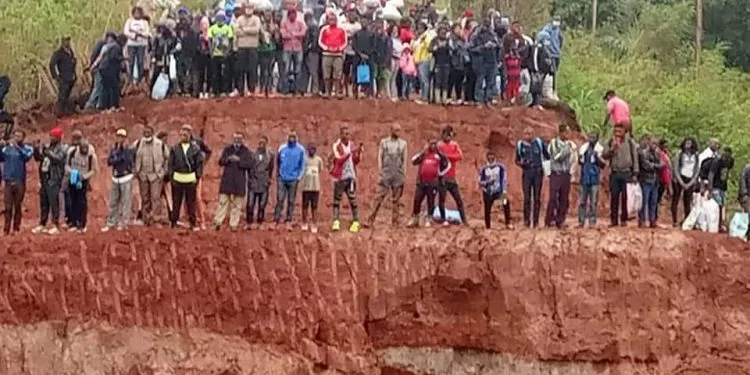Just like the Bamenda Ring Road project announced by President Paul Biya over three decades ago, the Babadjou-Bamenda road is another white elephant project of the new deal government that thrives in corruption.
A “white elephant project” is a phrase that is used in reference to a financial endeavour which fails to live up to its expectations. A “white elephant project” can be used in reference to the Babadjou-Bamenda road whose construction has been on since 2017.
The (re)construction of the Babadjou-Bamenda Road has gulped several billions of FCFA. To date, nothing is there to show for the huge sums of money pumped in.
From the look of things, the government of 88-year-old President Paul Biya, who has been in power since 1982, is not committed to deliver the road and is only using it to milk funds from the World Bank.
Successive ministers of public works have kept on giving false promises to the people of the North West Region who are in dire need of the Babadjou-Bamenda road.
Whenever the completion of the roads is expected, officials come up with flimsy excuses. It is either they complain of the rains or of insecurity. Indeed, what do contractors do throughout the dry season only to wake up during the rainy season to start complaining? Is the Babadjou-Bamenda road the only project that is in a security sensitive zone?
Fresh ‘fake’ promises
On the night of March 24-25, 2021, two highway embankments on the Babadjou-Bamenda road collapsed after heavy rains.
The situation paralysed traffic on the road for several hours leaving commuters stranded.
Several passengers travelling in and out of the North West region on Sunday were stranded along the stretch of road as movement of vehicles became practically impossible due to the fast-degrading nature of the road.
Vehicles cued up while passengers were forced to spend the entire night in cold. The coming of the rains has made matters worse for the stretch which has been begging for government’s attention for years now Analysts say the current state of the road is by every standard a source of public anger and vexation.
For days now, travelling to and from Bamenda has been nightmarish and remains a journey no one willingly wants to undertake.
Muddy and bumpy, the stretch of road, precisely around the locality of Nkoubou near Santa has virtually been impassable for days now.
A distant, which normally could be covered in 30 minutes, now takes as long as three hours with untold difficulties.
Hours later, Public Works Minister Emmanuel Nganou Djoumessi announced the resumption of traffic on the 59.9-km Babadjou-Bamenda road section of the Yaoundé-Enugu corridor leading to Nigeria.
The construction of the Babadjou-Bamenda road started in 2017. The works have suffered several setbacks including delays by utility companies to remove their installations.
A January 14, 2021, attack by armed secessionists from the North-West forced the contractor, Sogea Satom to withdraw citing force majeure caused by the security situation in the area.
The state has thus cancelled the construction contract it had awarded to Sogea Satom.
Minister Nganou Djoumessi said based on control missions’ reports and to avoid traffic disruption, local companies were mobilized to carry out some works that will allow the circulation of people and goods, pending the selection of a new contractor for the project.
Two local companies were mobilized for that purpose. The first was entrusted the works on the Babadjou side while the second was posted at the Santa side (Bamenda). In Babadjou, the traffic was restored but the company in charge of the works is still carrying out additional works to avoid another collapse of the embankments.
Meanwhile, on the Bamenda side, traffic is restored but users have to drive through thick mud. They are also compelled to wait for at least two hours after a downpour to ply the road.
FCFA 113 billion World Bank funding being pilfered?
The reconstruction of the Babadjou-Bamenda road section was launched in 2017, thanks to a $192 million (XAF113 billion) support from the World Bank.
The project was initiated to stop accidents and reduce transport costs and duration on the Yaoundé-Enugu corridor that connects to East Nigeria passing through Bafoussam and Bamenda, whose economy mainly relies on agriculture and commerce.
In January last year, the World Bank had rekindled fresh hopes for the tarring of the long-waited stretch of road which links the West to the North West region of the country.
In what was seen as a welcome relief to the people of the North West region, the Bretton Woods Institution had announced resumption of disbursements to fund tarring of the 35km stretch of road.
The announcement of the funding for the road was the major outcome of a meeting which took place in January 2020 to evaluate projects financed by the World Bank in Cameroon.
In addition to the construction of the stretch of the road between Babadjou and Bamenda, the project, valued at more than FCFA 37 billion, also includes the development of the Bamenda urban crossing, over a distance of 12km, as well as a 5km bypass.
Earlier in 2016, the World Bank pledged to fund the rehabilitation of the BabadjouBamenda road, which is being regarded by commuters as a death trap. The stretch of road has since been considered a nightmare to users over the years.
The BabadjouBamenda road is a dilapidated narrow stretch with potholes that have degenerated to yawning craters.
This makes it vulnerable to road accidents.
World Bank’s intervention was seen then as an end to the nightmare of persons using the road but the situation of the road has instead degenerated. It was reported that the World Bank had taken the engagement to rehabilitate the stretch as part of the trans-border road linking Cameroon and Nigeria.
This is, notably, the Bamenda-Enugu corridor. Besides rehabilitating the BabadjouBamenda stretch, the World Bank, it was said will also bankroll a by-pass that will create a new entrance into Bamenda. The by-pass begins from Bamenda Up Station, precisely where there is a billboard with the inscription ‘Welcome to Bamenda’.
It continues and meanders through Bamendankwe and joins the other stretch that leads to the Nkwen neighborhood near the Amour Mezam bus stop. The Babadjou-Bamenda stretch has been a source of public anger.
In 2015, it became so impassable that Babadjou people went on a rampage. They demonstrated and ignited a free-for-all cursing of the authorities. Same year, SDF chieftain, John Fru Ndi, stormed the road and sent away workers at the tollgate at Matazem near Santa.
The stretch that the World Bank had announced to rehabilitate is part of the Yaounde-Bafoussam-Bamenda highway that is noted for road accidents. It causes 11 percent of road accidents leading to 16 percent of deaths registered on Cameroonian roads, according to official sources.
For one thing, the World Bank, the African Development Bank, AfDB, and the Cameroon government shoulder the burden of rehabilitating the Yaounde-Bafoussam-Bamenda highway at the cost of FCFA 211, 851 billion. Out of the amount, the AfDB is providing 59.8 percent, the World Bank 27 .6 percent and the Cameroon government 12.5 percent. It should, however, be noted that the World Bank funding is separate from that of the AfDB that is covering the Yaounde-Bafoussam stretch of 212 km.
The localities of Babadjou and Bamenda road corridor will each benefit a 35km tarring of their roads. Meanwhile, 16km of urban expansion of the Bamenda-Babadjou road linking the Bamenda-Enugu road corridor will also be constructed. According to government sources, the construction of the Babadjou-Bamenda road would improve traffic flow as well as contribute to the development of the local socio-economic infrastructure of the nearby residents.
‘Complaints of insecurity are flimsy’
The government of Cameroon, or at least the company contracted for the Babadjou-Bamenda road, claim that the activities of armed separatists in the area make it difficult for works to progress.
True as this may seem, it is actually a show of bad faith on the part of the Cameroon government. In the heart of the Anglophone separatist crisis, several structures have been reconstructed in the troubled North West and South West regions.
The offices of Divisional Officers have been re-constructed and equipped in Bafut and at least five other subdivisions despite the smoking guns.
Just like the above projects, the Military Engineering Corps is known to have executed several development projects in very difficult security environments.
Cameroon’s Military Engineering Corps has five regiments – 1st Military Engineering Regiment in Sangmelima, 2nd in Douala, 3rd in Douala, 4th in Kousseri, and 5th in Bamenda.
Since its creation in 1962, the unit has carried out a series of key socio-economic projects. From 2016-2017, they rehabilitated the Douala and Maroua urban roads, the construction of the Ngaoundere Parcours Vita, passive communication networks and foot bridges in the Bakassi area, the Bertoua and Sangmelima modern markets as well as the Mora-Dabanga -Kousseri road in the Far North region. The World Bank financed this 205 km of road.
‘Anglophones don’t deserve development’
In 2018, Cameroon’s military took over the construction of roads at its northern borders with Chad and Nigeria after Chinese contractors abandoned the work following repeated attacks from armed Boko Haram fighters.
The work, which started on March 1, 2018, with the portion linking Mora-Dabanga and Kousseri in Cameroon, was interrupted in 2014 following an assault on the base camp of Chinese road contractors.
Boko Haram fighters kidnapped at least 10 workers and seized several equipment.
Despite the very horrible security porosity of the area, the military engineering corps stepped in and constructed the Mora-Dabanga and Kousseri road.
They are equally got involved in building classrooms and boreholes for the local population in some divisions of the Far North Region. This has gone a long way to contribute to social stability especially in some villages that were deserted due to the consistent attacks of the terrorist group Boko Haram.
With their heavy and light duty machines and well qualified staff, the combat engineers have shown their expertise and commitment in improving on the socio economic situation of their fatherland. The development they carried out in conflict arears have had the added reward of contributing to the overall security of the conflict area, for they provide direct assistance to the population.
In the case of the Babadjou-Bamenda road, Cameroon’s Military Engineering Corps has not been called in. The military is only interested in erecting symbols of occupation like administrative offices managed by colonial-style administrators.
This attitude of the authorities suggests that armed separatists fighting for the independence of the North West and South West Regions have a point. There are two Cameroons – one deserving of development and the other condemned to be occupied and conquered.
By Ashu Tidings



